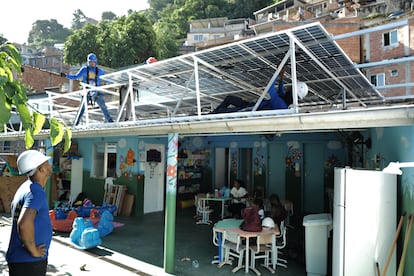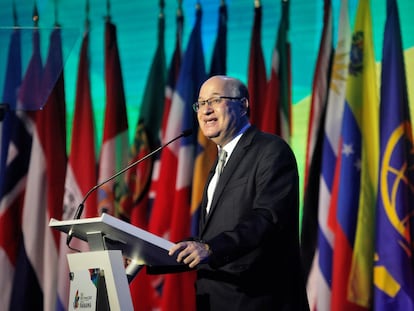Latin America must double its annual investment in energy to make the green transition by 2030
The IDB points out that the push for renewables, electromobility, green hydrogen, storage technologies, and energy integration are the key challenges


Latin America and the Caribbean are leading the world in the energy transition process. Between 2015 and 2022, the region increased its renewable capacity by 51% to reach 64% of electricity generation, mainly with hydroelectricity, solar, and wind energy. However, if the region wants to reach the goal of net zero emissions by 2050, the pace must accelerate. It is one of the messages that the Inter-American Development Bank (IDB) has raised at the institution’s Annual Meetings of the Boards of Governors that began this Wednesday in the Dominican city of Punta Cana.
Financing new projects in electromobility, developing transmission networks, green hydrogen, storage technologies, and energy integration is a challenge that governments today cannot face alone. Large, new investments are required “like perhaps never seen in the region,” warns an IDB expert. The organization estimates that if in recent years Latin America has spent an average of around $30 billion annually in the electricity sector, it must at least double that amount to $60 billion per year to accelerate the energy transition.

The body points out that it is investment that should come mostly from the private sector, considering what little ability the governments in the region have today to undertake this challenge. “The private sector has been called upon to fulfill a very important role in carrying out these new investment. In a context where Latin American governments are experiencing heavy tax restrictions and little capacity to take on debt, it is the private sector that should make these new investments,” the organization mentions.
Along these lines, the proposals to advance the transformation aim to move forward in decarbonizing various sectors of the economy, such as electricity, heating, transportation, industry, and construction. Likewise, the organization emphasizes, it is key to develop regulatory frameworks that facilitate the transition in the countries and accelerate permits that in many cases are slowing the fast pace of progress on these projects. This point is especially worrying in the field of electricity transmission, which is going ahead with decoupling from new energy generation projects.
Gabriel Melguizo, president of ISA Group, one of the main transmission groups in the region, warned delegates about this point. During his presentation at the “Accelerating the Energy Transition in Latin America” seminar, he pointed out that “Transmission is the great enabler of the energy transition. We need more networks, the world is going to have to increase the size of its networks two-and-a-half times because it is going to rely more and more on electricity,” he explained. The problem, he added, is that the delay of the projects is slowing down this progress. “Electricity generation is built in two to three years and networks take up to eight years to be built, there is a decoupling in the speed at which renewable energy and transmission projects can be built, and it is a global problem. In the US and Europe these projects take 12 years,” he warned.

But this is only one of the efforts needed to achieve the proposed goals. Alejandra Bernal-Guzmán, Latin American program officer of the International Energy Agency, mentioned in her presentation at the seminar that to achieve an accelerated energy transition by 2030, governments and business need to focus on three major challenges. The first is to make the transformation with a focus on people. Closing gaps in access to electricity, avoiding deaths caused by poisoning among people who do not have access to hygienic food preparation, and generating more than one million jobs in clean energy are some of the benefits to be had under this approach.
Another challenge, she explained, is to position the region within the global energy transition process by pushing the development of biofuels, green hydrogen, and critical minerals such as lithium, copper, and rare earths. These are key to the development of batteries, technology, and cables.
The third challenge, she noted, is to double investments in clean energy and develop energy efficiency. “The region is lagging behind in energy efficiency. One in three countries has put measures in place to get efficient equipment into homes and buildings, but it remains a huge challenge. A 20% reduction in consumption could be achieved only in efficient in buildings, transportation, and industry,” the expert added.
Sign up for our weekly newsletter to get more English-language news coverage from EL PAÍS USA Edition
Tu suscripción se está usando en otro dispositivo
¿Quieres añadir otro usuario a tu suscripción?
Si continúas leyendo en este dispositivo, no se podrá leer en el otro.
FlechaTu suscripción se está usando en otro dispositivo y solo puedes acceder a EL PAÍS desde un dispositivo a la vez.
Si quieres compartir tu cuenta, cambia tu suscripción a la modalidad Premium, así podrás añadir otro usuario. Cada uno accederá con su propia cuenta de email, lo que os permitirá personalizar vuestra experiencia en EL PAÍS.
¿Tienes una suscripción de empresa? Accede aquí para contratar más cuentas.
En el caso de no saber quién está usando tu cuenta, te recomendamos cambiar tu contraseña aquí.
Si decides continuar compartiendo tu cuenta, este mensaje se mostrará en tu dispositivo y en el de la otra persona que está usando tu cuenta de forma indefinida, afectando a tu experiencia de lectura. Puedes consultar aquí los términos y condiciones de la suscripción digital.
More information
Últimas noticias
Petro claims the ELN was the target of US attack in Venezuela
Maduro counterattacks Trump with rhetoric and announces downing of nine drug trafficking aircraft
‘Ecce Homo’: The miraculous disaster that made a small Spanish town famous
Return to sex testing at the Olympics: IOC edges closer to banning transgender women
Most viewed
- Sinaloa Cartel war is taking its toll on Los Chapitos
- Oona Chaplin: ‘I told James Cameron that I was living in a treehouse and starting a permaculture project with a friend’
- Reinhard Genzel, Nobel laureate in physics: ‘One-minute videos will never give you the truth’
- Why the price of coffee has skyrocketed: from Brazilian plantations to specialty coffee houses
- Silver prices are going crazy: This is what’s fueling the rally









































